Are you tired of ending up with overcooked or undercooked eggs every time you attempt to boil them? Look no further! In this blog post, we will unravel the mystery behind achieving perfectly cooked hard-boiled eggs.
Whether you prefer stovetop boiling, steaming, or even baking, we’ve got you covered with step-by-step instructions for each method. Plus, we’ll share some insider tips and tricks to take your egg-cooking game to a whole new level. So grab your apron, and let’s dive into the wonderful world of hard-boiled eggs!
How to Hard Boil Eggs?
Method 1: Stovetop Boiling
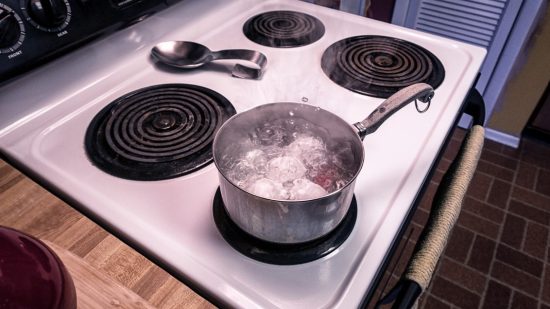
Boiling eggs on the stovetop is the traditional and most common method for hard-boiling eggs. It’s a straightforward process that anyone can master with a little practice.
- Place your eggs in a single layer in a saucepan or pot. Make sure not to overcrowd them, allowing each egg to cook evenly.
- Fill the pot with enough cold water to cover the eggs by about an inch (2.5 cm).
- Put the pot on the stove over medium-high heat and bring the water to a rolling boil.
- Once the water reaches a rolling boil, reduce the heat slightly to maintain a gentle, steady boil.
- Let the eggs boil for about 9-12 minutes for a fully cooked yolk. Adjust the time depending on your preference: 6-8 minutes for a soft-boiled yolk or 9-10 minutes for a medium-boiled yolk.
- While the eggs are boiling, prepare a bowl of ice water. This will help cool down the eggs quickly and stop the cooking process.
- After the desired cooking time has elapsed, use a slotted spoon or tongs to carefully transfer the eggs from the pot to the ice water bath.
- Allow the eggs to sit in the ice water for at least 5 minutes to cool down completely. This will also make peeling easier.
- Once the eggs have cooled, gently tap each one on a hard surface to crack the shell all over. To remove the egg’s shell, roll it between your palms and then pull it off. Any hard-to-remove shell bits can be helped by peeling under running water.
Stovetop boiling offers simplicity and reliability when it comes to achieving perfectly cooked hard-boiled eggs every time!
Method 2: Steaming
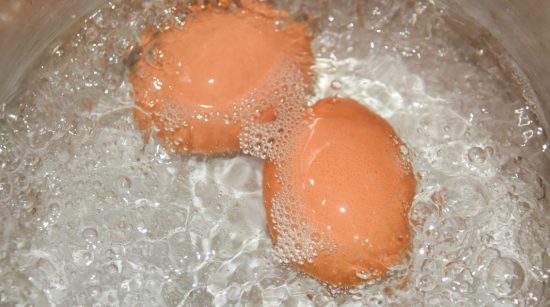
Steaming is another great method for hard-boiling eggs. It’s a slightly different approach than traditional stovetop boiling, but it yields equally delicious results.
Here’s how to do it:
- Fill a pot with about an inch (2.5 cm) of water and place a steamer basket or rack inside. Make sure the water level is below the steamer level.
- Place your eggs on the steamer basket or rack, ensuring they are manageable and have enough space to cook evenly.
- Cover the pot with a lid and turn the heat to high, allowing the water to come to a boil.
- Once the water is boiling, reduce the heat to medium-low to maintain a gentle steam.
- Steam the eggs for about 10-12 minutes for a fully cooked yolk. Adjust the time according to your preference: 7-9 minutes for a soft-boiled yolk or 9-11 minutes for a medium-boiled yolk.
- While the eggs are steaming, prepare a bowl of ice water. This will help cool down the eggs quickly and stop the cooking process.
- After the desired cooking time has elapsed, use tongs or a slotted spoon to carefully transfer the steamed eggs from the pot to the ice water bath.
- Allow the eggs to sit in the ice water for at least 5 minutes to cool down completely. This will also make peeling easier.
- Once the eggs have cooled, gently tap each one on a hard surface to crack the shell all over. Gently roll the egg in your palms to release the shell, then carefully peel it off. Any obstinate shell bits can be removed by peeling under running water.
Now, you have perfectly hard-boiled eggs using the steaming method! Enjoy them in salads, sandwiches, or as a healthy snack.
Method 3: Baking
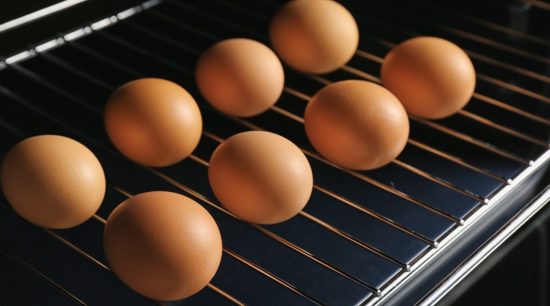
Baking eggs may not be the most common method for hard boiling, but it can yield delicious results. This technique allows for a more hands-off approach, as you simply pop the eggs in the oven and let them do their thing.
Here’s how to do it:
- Preheat your oven to 325°F (160°C).
- Place your eggs directly on the oven rack or in a muffin tin to keep them from rolling around.
- Bake the eggs in the preheated oven for about 25-30 minutes.
- While the eggs are baking, prepare a bowl of ice water. This will help cool down the eggs quickly and stop the cooking process.
- Once the eggs are baked, use tongs or a spoon to transfer them to the ice water bath carefully.
- Allow the eggs to sit in the ice water for at least 5 minutes to cool down completely. This will also make peeling easier.
- After the eggs have cooled, gently tap each one on a hard surface to crack the shell all over. To remove the shell, roll the egg between your palms to release it. Any hard-to-remove shell pieces can be helped by peeling under running water.
| Method | Steps |
| Stovetop | 1. Place eggs in a single layer in a saucepan. 2. Fill pot with enough cold water to cover eggs by about an inch. 3. Bring water to a boil, then reduce heat and simmer for 9-12 minutes. 4. Prepare ice water bath. 5. Transfer eggs to ice water after cooking time. 6. Let eggs cool for at least 5 minutes before peeling. |
| Steaming | 1. Place steamer basket in pot with about an inch of water. 2. Put eggs in the basket, cover pot, and steam for 10-12 minutes. 3. Prepare ice water bath. 4. Move eggs to ice water once done steaming. 5. Allow eggs to cool for 5 minutes before peeling. |
| Baking | 1. Preheat oven to 325°F (160°C). 2. Place eggs on oven rack or in muffin tin, bake for 25-30 minutes. 3. Prepare ice water bath. 4. Transfer eggs to ice water when baking is complete. 5. Let eggs cool for at least 5 minutes before peeling. |
Tips and Tricks for Perfectly Cooked Eggs
When it comes to hard-boiling eggs, there are a few tips and tricks that can help you achieve the perfect result every time. Here are some secrets to ensure your eggs turn out just right.
- Bring cold eggs to room temperature quickly by placing them in warm water for a few minutes before cooking. This promotes even cooking and prevents cracking.
- Place eggs gently in a single layer in the pot. Overcrowding can lead to uneven cooking. Ensure water covers the eggs by about an inch.
- Bring water to a boil over high heat, then reduce to a gentle simmer. Consistent simmering ensures even cooking.
- Simmer medium-sized eggs for 9-12 minutes, adjusting based on preference for softer or firmer yolks.
- After cooking, immediately transfer hot eggs to an ice bath using tongs or a slotted spoon. This stops cooking and facilitates easy peeling.
- Allow eggs to cool for around 10 minutes before peeling. Cooling aids in separating the egg white from the shell.
- Gently tap each egg on all sides against a hard surface to crack the shell. Peel under cool running water for a smoother process.
Remember these tips next time you want perfectly cooked hard-boiled eggs! With practice, patience, and attention to detail – achieving that ideal texture will become second nature.
Nutritional Information of Hard-Boiled Eggs
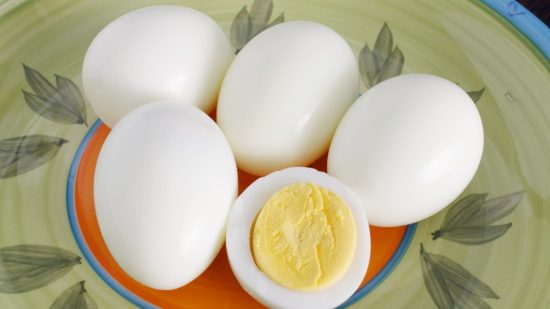
Hard-boiled eggs are not only delicious but also packed with essential nutrients. Here is the nutritional information for a large-sized hard-boiled egg:
- Calories: 78
- Protein: 6.3 grams
- Fat: 5.3 grams
- Saturated fat: 1.6 grams
- Monounsaturated fat: 2 grams
- Polyunsaturated fat: 0.7 grams
- Cholesterol: 186 milligrams
- Carbohydrates: 0.6 grams
- Sugars: 0.6 grams
- Fiber: 0 grams
- Sodium: 62 milligrams
- Potassium: 63 milligrams
- Vitamin A: 75 micrograms
- Vitamin B12: 0.6 micrograms
- Vitamin D: 1.6 micrograms
- Calcium: 28 milligrams
- Iron: 0.9 milligrams
Incorporating hard-boiled eggs into your diet can provide you with a nutritious boost while adding variety to your meals!
Top 5 Recipes Made Using Hard-boiled Eggs
Egg Salad Sandwich
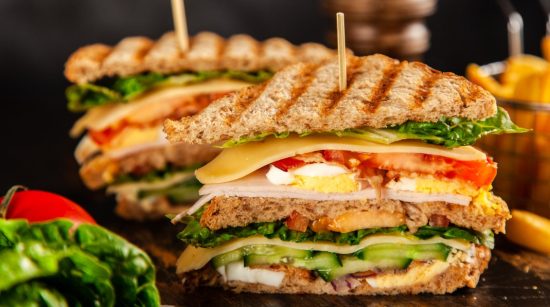
A classic and versatile choice, the egg salad sandwich offers a perfect solution for utilizing hard-boiled eggs. Begin by chopping the eggs and creating a delightful mixture with mayonnaise, mustard, salt, and pepper. For an extra layer of texture and flavour, add diced celery or onions. Once combined, generously spread this flavorful mixture on your preferred bread or roll. The result is a satisfying lunch option that never fails to please, combining the simplicity of preparation with a timeless taste.
Deviled Eggs
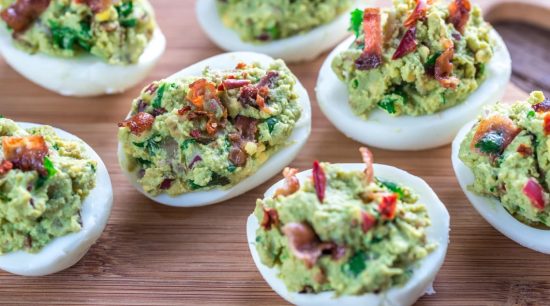
Deviled eggs stand as a timeless appetizer, consistently stealing the show at parties and gatherings. The process involves cutting hard-boiled eggs in half lengthwise and delicately scooping out the yolks into a bowl. Mash the yolks with mayonnaise, Dijon mustard, salt, pepper, and additional desired seasonings like paprika or hot sauce. This creamy filling is then meticulously spooned back into the awaiting egg white halves, creating an elegant yet straightforward treat that remains a crowd-pleaser.
Cobb Salad
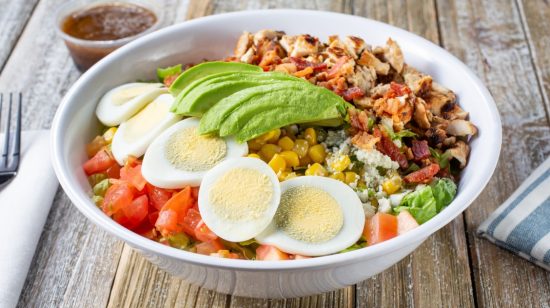
The Cobb salad reaches new heights of deliciousness with the incorporation of hard-boiled eggs. Craft a vibrant bed of mixed greens and crown it with an array of delightful toppings, including chopped tomatoes, avocado slices, and crispy bacon bits. The addition of hard-boiled eggs contributes both protein and richness to the ensemble. Drizzle your favourite dressing over this colourful arrangement to create a hearty and flavorful salad that excites the palate.
Nicoise Salad
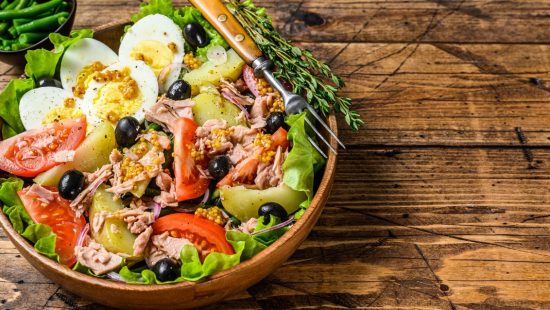
Originating from Nice, the Nicoise salad is a symphony of bold Mediterranean flavours. Comprising various ingredients such as boiled potatoes, blanched green beans, sliced tomatoes, canned tuna, olives, capers, and, notably, hard-boiled eggs, this salad offers a delightful array of tastes and textures. The hard-boiled eggs bring a satisfying richness to the ensemble, making it a standout dish that captures the essence of the Mediterranean culinary experience.
Egg Curry
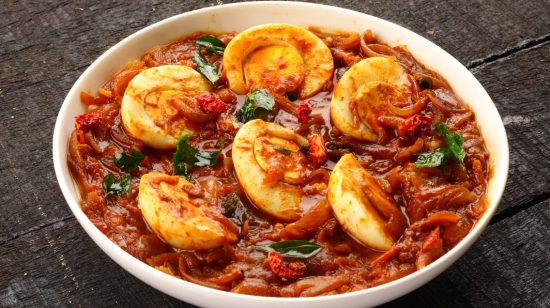
Hard-boiled eggs take centre stage in this flavorful and hearty main dish – the egg curry. Cooked in a luxurious tomato-based gravy infused with aromatic spices such as cumin seeds, turmeric, coriander powder, and garam masala, this dish is a celebration of rich and complex flavours. The eggs absorb the essence of the spices, creating a harmonious blend that elevates the humble hard-boiled egg to a standout culinary creation. Enjoy the depth of taste and satisfaction that egg curry brings to the dining table.
Conclusion
In conclusion, hard-boiling eggs are a simple and versatile cooking method that can be used for breakfast, snacks, or as an ingredient in various recipes. With the right technique and timing, anyone can easily achieve perfectly cooked hard-boiled eggs. Whether enjoyed on their own or incorporated into dishes, hard-boiled eggs are a delicious and nutritious addition to any meal.
By following the steps and tips outlined in this guide, you will be able to consistently create perfectly hard-boiled eggs every time. So go ahead and impress your friends and family with your egg-cooking skills!
FAQs – How to Hard Boil Eggs?
Why are Hard-Boiled Eggs Difficult to Peel?
Hard-boiled eggs can be challenging to peel due to the pH level of the egg whites. Fresher eggs have a lower pH, making the proteins bond tightly to the membrane. Ageing eggs or adding baking soda to the boiling water may help loosen the bond and ease peeling.
Why Put Vinegar in Eggs When Boiling Them?
Adding vinegar to boiling water increases the water’s acidity, helping to prevent egg whites from leaking out of any cracked eggs. It may also contribute to easier peeling by affecting the pH level of the egg whites.
Does Adding Salt to Water Make Hard-Boiled Eggs Easier to Peel?
Yes, adding salt to boiling water may help make hard-boiled eggs easier to peel. The salt can penetrate the eggshell and denature the proteins, potentially reducing the bond between the egg whites and the membrane.
Do You Put Eggs in Boiling Water or Cold?
Start eggs in cold water, bring them to a boil, then reduce the heat to a simmer. Starting in hot water increases the chances of cracking due to rapid temperature changes. The gradual increase in temperature helps prevent cracking and promotes even cooking.

